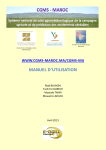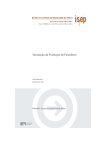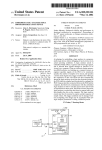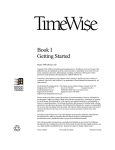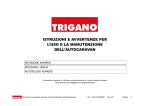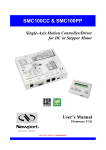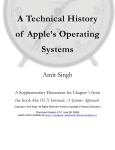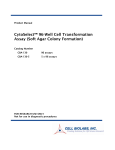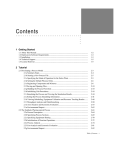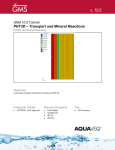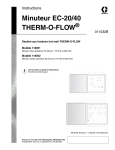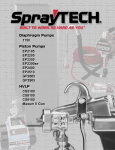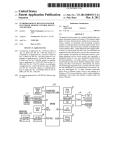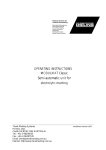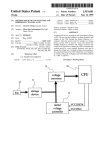Download Method of distributing piracy protected computer software
Transcript
US006721891B1 (12) United States Patent (16) Patent N6.= Borza ( 54) (75) US 6,721,891 B1 (45) Date of Patent: METHOD OF DISTRIBUTING PIRACY Inventor; 5,848,231 A Stephen J_ Borza, Ottawa (CA) Assigneez Activcard (IE) Ireland ( * ) Notice: Apr. 13, 2004 * 12/1998 Teitelbaum et a1. ....... .. 713/200 5,893,910 A 4/1999 5,933,498 A * 8/1999 Schneck et al. 6,044,471 A * 3/2000 Colvin .............. .. 713/202 6,087,955 A 7/2000 Gray ......... .. * Martineau et al. .......... .. 707/10 705/54 340/82534 6,314,409 B2 OTHER * 11/2001 PUBLICATIONS Schneck CI 8.1. ............ .. Subject to any disclaimer, the term of this patent is extended or adjusted under 35 U.S.C. 154(b) by 0 days. sénderson, “Distributed ?le System53 Stepping Stone to dis‘ mbuted Computlng” May 1991, LAN Technology, VOL 7, #5, p- 41—50-* * cited by examiner (21) Appl. No.: 09/277,827 (22) Filed: _ Mar- 29, 1999 Int Cl 7 H0 4L 9/32 (52) (58) US. Cl. ..................................................... .. 713/202 Field of Search ............................... .. 713/200, 201, 713/202 902/25 26 379/211 05 340/5 6 5 65 5 8 5’81 5 82’ 5 ’ ' (56) ’ ' ’ _ Assistant Examiner—Christopher Revak (51) ' _ Primary Examlner—Ga1l Hayes ' ’ 455/55, $0567 ' ’ ’ (74) Attorney, Agent, or Firm—Freedman & Associates (57) ABSTRACT Amethod and a system for disabling execution of a softWare application stored Within a computer absent data indicative ' of an authoriZed use of the softWare application are dis References Cited closed. At start up or during execution of a softWare appli U.S. PATENT DOCUMENTS cation a user is prompted for user authoriZation information. Using a processor Within a smart card the received user 4 658 093 A 4:683:553 A * 4/1987 Hellman .................... .. 380/25 8119081810“infmma?onis Compared With user authorize" 7/1987 t1on information stored in memory of the Mower _ _ _ _ _ _ _ _ _ _____" 4,791,565 A 4 12/1988 Dunham et aL __ 5,260,999 A 4 5,495,411 A * 11/1993 Wyman ________ 380/4 364/200 _ _ _ _ _ __ 2/1996 Ananda smart card to produce a comparison result. If the comparison result is 380/4 indicative of an authoriZed user of the softWare application, 364/401 then data indicative of the authoriZed use of the softWare 5,509,070 A * 4/1996 Schull 380/4 application is provided from the smart card to the computer. 5,615,061 A 3/ 1997 Singh ------------------------ -- 360/60 5,625,690 A 4/1997 Michel ct a1~ ~~~~~~~~~~~~~~~ ~~ 380/4 5’692’917 A * 12/1997 Rleb et a1‘ 439/225 Upon receipt of the data indicative of the authoriZed use of the softWare application execution of the softWare applica tion is continued. When the data is not data indicative of the 2 * 5:757:907 A 5,790,663 A 5,790,668 A 5,796,824 A u authoriZed use of thesoftware application further execution 5/1998 Cooper et a1. ............... .. 380/4 * of th? _S°?Ware_aPPhCat1°n 1S dlsabled' F0? example’ blo' 8/1998 Lee et a1. .................... .. 380/4 meme lnformatlon 1“ the form of a ?ngerpnm may be used 8/1998 Tomko ....... .. . 380/25 for user authorila?on 8/1998 Hasebe et a1. . .... .. 380/4 5,841,868 A * 11/1998 Helbig, Sr. ................ .. 380/25 5 Claims, 10 Drawing Sheets COMPUTER SMARTCARD Require Key Receive Request Receive Request Require User Authorisation Prompt User for Authorisation Receive User Authorisation from Input Device ‘Transmit User Authorisation|—_>i Receive User Authorisation Compare Reserved UA with Stored UA OK 7 ls Key One of Plurality of Keys to Unlock Yes SWA” Package Key Yes Transmit Key Select Version of SWA Related to the Provided Key , Continue Execution with Selected Version of SWA U.S. Patent Apr. 13, 2004 Sheet 1 0f 10 US 6,721,891 B1 10 / E /30 Figure 1a 40 COMPUTER SMARTCARD Execute Software Application Require Key from ———> Receive Request for Key Smartcard Receive Key from Smartcard Prompt User l 4 Provide Key to Computer Key for Correct 4-No Correct? Smartcard Yes v Continue Execution Figure 1b U.S. Patent Apr. 13,2004 Sheet 2 0f 10 US 6,721,891 B1 Figure 2a COMPUTER SMARTCARD Start Installation of Software l Provide Serial Number of Processor Store Serial Number of Processor in Write Once ROM Serial Number Sto red l Continue Installation Figure 2b U.S. Patent Apr. 13, 2004 COMPUTER US 6,721,891 B1 Sheet 3 0f 10 SMARTCARD Execute Software l Provide Serial Number A» Receive Serial Number l Serial Number OK Compare Serial Number with Stored Serial Number if OK. i Continue Execution Figure 2c 10 \ 42 40 54 44 52 y 60 a W70 50 Figure 3a US. Patent Apr. 13, 2004 COMPUTER US 6,721,891 B1 Sheet 4 0f 10 BIOMOUSE PLUS w Execute SWA i Require Key Display Prompt ' Transmit Request ——> Receive Request , Transmit Prompt _ l Prompt User for UA Receive UA from User + Receive UA Compare UA Received with UA Stored OK ? Yes Package Key i Receive Key Transmit Key Provide Key Figure 3b Continue Execution U.S. Patent Apr. 13, 2004 Sheet 5 0f 10 US 6,721,891 B1 10 Figure 4b U.S. Patent Apr. 13, 2004 COMPUTER Sheet 6 0f 10 US 6,721,891 B1 SMARTCARD Execute SWA ———>i Require Key and Provide SWA Data ‘———> Receive Request and SWA Data Receive Request <———— Require User Authorisation iv Prompt User for Authorisation + Receive User Authorisation from Input Device Transmit User Authorisation _> Receive User Authorisation Compare Receive Key <— Received UA with Stored UA Yes Y Select Key from Plurality of Keys Related to SWA Data iv Package Key + Yes Transmit Key + Continue Execution of SWA Figure 5 U.S. Patent Apr. 13, 2004 US 6,721,891 B1 Sheet 7 0f 10 SMARTCARD COMPUTER Execute SWA i —> Require Key _________—_—’i Receive Request i Receive Request Require User Authorisation iv Prompt User for Authorisation + Receive User Authorisation from Input Device Transmit User Authorisation ———> Receive User Authorisation Receive Key Compare Received UA With Stored UA of Plurality of sers. OK ’? Yes i Yes Package Key i i Continue Execution of SWA Transmit Key Figure 6 U.S. Patent Apr. 13, 2004 Sheet 8 0f 10 CQMPUTER US 6,721,891 B1 SMARTCARD Execute SWA Require Key —————H Receive Request Receive Request <— Require User Authorisation + Prompt User for Authorisation + Receive User Authorisation from Input Device Transmit User Authorisation —_> Receive User Authorisation Receive Key <—————— Compare Received UA with Stored UA OK ’? ——No Is Key One of Plurality of Keys to Unlock Yes SWA? Package Key Yes Transmit Key 7 l v Select Version of SWA Related to the Provided Key l Continue Execution With Selected Version of SWA Figure 7a U.S. Patent Apr. 13, 2004 Sheet 10 0f 10 COMPUTER US 6,721,891 B1 SMARTCARD Execute SWA . ——> Receive Request Require Key Do Display <———No @ Additional Data Permit Execution Yes Receive Request 4—...— Require User Authorisation Prompt User for Authorisation t Receive User Authorisation from Input Device + Receive User Authorisation Transmit User Authorisation Receive Key Compare Received UA with Stored UA OK ? Is Key the Key to Unlock SWA? Yes V Yes Package Key i Transmit Key Continue Execution of SWA Figure 8 US 6,72l,89l B1 1 2 METHOD OF DISTRIBUTING PIRACY PROTECTED COMPUTER SOFTWARE into all aspects of business and daily life—?nancial, medical, education, government, and communications—the concern over secure ?le access is groWing. Using passWords is a common method of providing security. PassWord pro tection is employed for computer netWork security, auto FIELD OF THE INVENTION This invention relates generally to a method for disabling execution of a software application stored Within a computer absent data indicative of an authorised use of the softWare application and more particularly relates to a method for disabling execution of a softWare application using a smart card. matic teller machines, telephone banking, calling cards, and telephone ansWering services. These systems generally require knoWledge of an entry code that has been selected by a user or has been con?gured in advance. Examples of 10 commonly used security codes for preventing softWare piracy include information from a user’s manual and a serial number. Unfortunately for use in copy protection, security codes are unWorkable since the softWare is easily transferred BACKGROUND OF THE INVENTION Software piracy is causing huge losses in pro?ts for companies developing and selling computer softWare. The 15 secure access and does not require a passWord or access code is a biometric identi?cation system. A biometric identi?ca sale and distribution of softWare designed for general use is based on the assumption that a softWare provider only tion system accepts unique biometric information from a user and identi?es the user by matching the information Wishes to sell a right to use the softWare to one person or to a select group of people. The seller speci?cally does not Wish the purchaser to distribute the softWare to other users or to resell the softWare. Various methods are employed to 20 gerprint recognition system. The use of a biometric imaging device With a personal computer is becoming Widespread. In a ?ngerprint input most common method of softWare distribution is via a 25 copying the softWare from this storage medium to another sensing means such as an interrogating light beam. Various on different computers. This results in undesirable softWare piracy. 30 a second surface disposed at an acute angle to the ?rst surface through Which the ?ngerprint is vieWed and a third illumination surface through Which light is directed into the ?oppy disk, that is copy protected becomes damaged, the softWare application along With the original copy to lessen inconvenience When the original copy is damaged, but sometimes even these “backup” copies fail. Some softWare providers have avoided softWare copy protection schemes. Instead these softWare providers rely on the honesty of the purchaser, the fact that the documentation 35 prism. In some cases, the illumination surface is at an acute angle to the ?rst surface, as seen for example, in US. Pat. Nos. 5,187,482 and 5,187,748. In other cases, the illumina tion surface is parallel to the ?rst surface, as seen for example, in US. Pat. Nos. 5,109,427 and 5,233,404. Fin 40 puter terminals. purchaser is expected to honour. The license agreement providers vieW convenience as essential for softWare users 45 and therefore are Wary of softWare piracy protection meth capacitors, each comprising a pair of spaced electrodes, Another method of softWare protection involves Writing to an installation disk to indicate that installation has 50 occurred. This limits a disk to one use. This has many of the aforementioned draWbacks and also is unWorkable With CD provider Writes a program and other information to a CD hence, the capacitance of the capacitors. In one arrangement, 55 the capacitors of each column are connected in series With the columns of capacitors connected in parallel and a voltage is applied across the columns. In another arrangement, a 60 methods of preventing undesired proliferation of pirated softWare can not be applied; users require some form of backup and this backup is easily distributed to other users. voltage is applied to each individual capacitor in the array. Sensing in the respective tWo arrangements is accomplished by detecting the change of voltage distribution in the series connected capacitors or by measuring the voltage values of the individual capacitances resulting from local deforma tion. To achieve this, an individual connection is required from the detection circuit to each capacitor. Also, interception of softWare by unauthorised third parties Computer security is fast becoming an important issue. With the proliferation of computers and computer netWorks carried in a sensing member and covered by an insulating ?lm. The sensors rely upon deformation to the sensing member caused by a ?nger being placed thereon so as to vary locally the spacing betWeen capacitor electrodes, according to the ridge/trough pattern of the ?ngerprint, and ROM technology. Using CD ROM technology, a softWare is a signi?cant risk to softWare providers. US. Pat. No. 4,353,056 in the name of Tsikos issued Oct. 5, 1982, discloses an alternative kind of ?ngerprint sensor that uses a capacitive sensing approach. The described sensor has a tWo dimensional, roW and column, array of ods that inconvenience users in any Way. ROM Which can be Written to only once using special hardWare for that purpose. Therefore, adding information to a CD ROM during installation is not possible. With the increasing use of digital communications such as the Internet, computer softWare is noW commonly distrib uted using these means. In this case, the aforementioned gerprint identi?cation devices of this nature are generally used to control the building-access or information-access of individuals to buildings, rooms, and devices such as com is dif?cult to duplicate, and/or a license agreement that the makes it illicit to distribute the softWare. Many softWare optical devices are knoWn Which employ prisms upon Which a ?nger Whose print is to be identi?ed is placed. The prism has a ?rst surface, a platen, upon Which a ?nger is placed, to prevent a purchaser from making a back up copy of a softWare application. When a storage medium, such as a softWare provider must replace the storage medium. Some softWare providers have included a backup copy of the transducer or sensor, the ?nger under investigation is usually pressed against a ?at surface, such as a side of a glass plate; the ridge and valley pattern of the ?nger tip is sensed by a one or installing the softWare from a same storage medium In the past, piracy protection schemes Were implemented against information belonging to registered users of the system. One such biometric identi?cation system is a ?n prevent the purchaser from distributing the softWare. The storage medium. The user is often unrestricted from either With the security code. A security access system that provides substantially 65 Before the advent of computers and imaging devices, research Was conducted into ?ngerprint characterisation and identi?cation. Today, much of the research focus in biomet US 6,721,891 B1 3 4 rics has been directed toward improving the input transducer and the quality of the biometric input data. Fingerprint receiving user authorisation information from an input characterisation is Well knoWn and can involve many aspects transmitting the user authorisation information to a second device disposed Within a ?rst housing; processor Within a second housing, the second housing comprising memory, Wherein the user authorisation infor mation is unavailable to the ?rst processor; using the second processor, comparing the received user authorisa of ?ngerprint analysis. The analysis of ?ngerprints is dis cussed in the folloWing references, Which are hereby incor porated by reference: Xiao Qinghan and Bian Zhaoqi,: An approach to Fingerprint Identi?cation By Using the Attributes of Feature Lines of Fingerprint,” IEEE Pattern Recognition, pp 663, 1986; C. B. Shelman, “Fingerprint Classi?cation—Theory and tion information With user authorisation information 10 Application,” Proc. 76 Carnahan Conference on Elec second processor to the ?rst processor, the data indicative of the authorised use of the softWare application on the tronic Crime Countermeasures, 1976; Feri Pernus, Stanko Kovacic, and Ludvik Gyergyek, “Minutaie Based Fingerprint Registration,” IEEE Pattern Recognition, pp 1380, 1980; stored in memory to produce a comparison result and, if the comparison result is indicative of the authorised user of the softWare application, providing data from the 15 ?rst processor; and, executing a second portion of the softWare application only J. A. Ratkovic, F. W. Blackwell, and H. H. Bailey, “Concepts for a Next Generation Automated Fingerprint System,” upon receipt of the data indicative of the authorised use of Proc. 78 Carnahan Conference on Electronic Crime In accordance With another aspect of the invention there is provided a system for protecting a softWare application the softWare application. Countermeasures, 1978; from piracy comprising: K. Millard, “An approach to the Automatic Retrieval of Latent Fingerprints,” Proc. 75 Carnahan Conference on Electronic Crime Countermeasures, 1975; Moayer and K. S. Fu, “A Syntactic Approach to Fingerprint Pattern Recognition,” Memo Np. 73—18, Purdue University, School of Electrical Engineering, 1973; a softWare application for execution on a computer, the softWare application including executable commands for preventing execution of a portion of the softWare appli cation absent data indicative of an authorised use of the 25 Wegstein, An Automated Fingerprint Identi?cation System, softWare application; and a peripheral device including: a housing; NBS special publication, US. Department of Commerce/ a port for interfacing the peripheral device to the computer; memory Within the housing, the memory for storing user National Bureau of Standards, ISSN 0083—1883; no. 500—89, 1982; authorisation information indicative of an authorised user Moenssens, Andre A., Fingerprint Techniques, Chilton Book Co., 1971; and, Wegstein and J. F. Rafferty, The LX39 Latent Fingerprint Matcher, NBS special publication, of the softWare application; and, a processor Within the housing for receiving authorisation information provided by a user, for comparing received US. Department of Commerce/National Bureau of Stan authorisation information With the user authorisation dards; no. 500—36, 1978. softWare application stored Within a computer absent data information stored in the memory to produce a compari son result and, if the comparison result is indicative of an authorised user of the softWare application, providing data from the device to the computer, the data indicative of an indicative of an authorised use of the softWare application using a smart card. computer, OBJECT OF THE INVENTION 35 It is an object of this invention to disable execution of a authorised use of the softWare application on the Wherein the softWare application execution is at least par STATEMENT OF THE INVENTION tially prevented until the data indicative of the authorised use of the softWare application is received. In accordance With the invention there is provided a method for protecting a softWare application from piracy comprising the steps of: 45 device also comprises a biometric sensor in the form of a providing data indicative of an authorised use of the soft Ware application; ?ngerprint imager. executing a ?rst portion of the softWare application; receiving user authorisation information; using a processor Within a peripheral device, comparing the BRIEF DESCRIPTION OF THE DRAWINGS An exemplary embodiment of the invention Will noW be described in conjunction With the attached draWings, in received user authorisation information With user autho Which: FIG. 1a is a simpli?ed diagram of a system according to the invention for protecting a softWare application from risation information stored in memory of the peripheral device to produce a comparison result and, if the com parison result is indicative of the authorised user of the softWare application, providing data from the peripheral Preferably the peripheral device comprises a smart card reader and a smart card. More preferably, the peripheral 55 piracy using a smart card; FIG. 1b is a simpli?ed ?oW diagram of a method accord device to the computer, the data indicative of the autho rised use of the softWare application on the computer; and, ing to the invention for protecting a softWare application from piracy using the system described in FIG. 1a; executing a second portion of the softWare application only the softWare application. FIG. 2a is a simpli?ed diagram of a system according to the invention for protecting a softWare application from In accordance With the invention there is also provided a piracy storing a serial number of a processor memory of a method for protecting a softWare application from piracy comprising the steps of: smart card; FIG. 2b is a simpli?ed ?oW diagram of an installation of a softWare application using the system described in FIG. upon receipt of the data indicative of the authorised use of providing data indicative of an authorised use of the soft Ware application; executing a ?rst portion of the softWare application using a ?rst processor; 65 2a; FIG. 2c is a simpli?ed ?oW diagram of an execution of a softWare application using the system described in FIG. 2a; US 6,721,891 B1 5 6 FIG. 3a is a simpli?ed diagram of a preferred embodiment of a system according to the invention for protecting a softWare application from piracy comprising a smart card reader With a contact imager disposed therein; FIG. 3b is a simpli?ed ?oW diagram of a method accord ing to the invention for protecting a softWare application use of the application to systems in communication With the one unique smart card. In a further embodiment, the smart card is provided With security such as a passWord or biometric information veri ?cation to prevent theft of the softWare or unauthorised use thereof. Though the method according to the invention is described With reference to ?ngerprint registration, it is applicable to other biometric information and methods of from piracy using the system described in FIG. 3a; FIG. 4a is a simpli?ed diagram of a system according to the invention for protecting a softWare application from piracy comprising a smart card reader and a contact imager user authentication using that biometric information. An individual’s biometric information in the form of a connected to a computer; ?ngerprint, retinal scan, palm print, voice print, etc. from a FIG. 4b is a simpli?ed diagram of a system according to the invention for protecting a softWare application from piracy comprising a smart card With a contact imager; FIG. 5 is a simpli?ed ?oW diagram of a method according to the invention for protecting a softWare application from piracy using one smart card for different softWare applica biometric information source in the form of a ?ngertip, eye, hand, voice, etc. is captured using a biometric information 15 imager, a ?ngerprint is digitised and, using a processor, the digitised ?ngerprint is characterised. Characterisation of ?ngerprints is knoWn in the art of ?ngerprint analysis and, in general involves extracting features in a substantially tions; FIG. 6 is a simpli?ed ?oW diagram of a method according to the invention for protecting a softWare application from piracy using one smart card for different users; FIG. 7a is a simpli?ed ?oW diagram of a method accord ing to the invention for protecting a softWare application from piracy using different versions of the softWare appli input device in the form of a contact imager, eye scanner, or a microphone. Contact imager, as described above, are knoWn in the art of electronic security. Using a contact global reference frame for comparison against template 25 cation for different users; FIG.7b is a simpli?ed diagram of a computer netWork for features. The characterised digitised biometric information is reg istered With stored templates to locate a template that, Within a predetermined level of security in the form of a predeter mined false acceptance rate, matches the characterised infor mation. When a match is detected, the individual is identi implementing the method described in FIG. 7a; and, ?ed and a corresponding action is performed. Alternatively, FIG. 8 is a simpli?ed ?oW diagram of a method according to the invention for protecting a softWare application from piracy storing additional data on the smart card. When identi?cation is not necessary the individual is authen ticated. Some knoWn actions performed based on biometric authentication include system access, unlocking a door, logging access, providing personal information, billing an DETAILED DESCRIPTION With the advent of personal computers, softWare piracy— individual, etc. Referring to FIGS. 1a and 1b, a simpli?ed diagram of a method to protect a softWare application from 35 copying softWare in Which copyright exists—proliferated. provider during packaging customises a softWare applica With the implementation of graphical user interfaces, copy tion 20 to a particular smart card 40. The smart card 40 and ing softWare has become a matter of dragging ?les from an original diskette to a blank diskette. In fact, softWare piracy is so proli?c that it is estimated that more than one half of softWare in use today is pirated. Obviously, it is in the best interests of softWare providers to reduce softWare piracy. In the speci?cation and claims that folloW all items peripheral to computer functionality such as disk drives including hard disk drives, smart card readers, scanners, keyboards, printers, imaging devices, etc. are referred to as piracy according to the invention is shoWn. A softWare 45 the softWare application 20 are then packaged together for sale. The smart card 40 and the softWare application 20 Within the package function to provide a purchaser With operational softWare. Absent the smart card 40, the softWare application 20 Will not function. Such a softWare package is not easily pirated. Either the softWare instructions requiring the presence of the smart card are removed, or the smart card is duplicated. Neither of these is easily accomplished. Therefore, simple drag and drop piracy is prevented greatly reducing the amount of peripheral devices. The invention provides a unique method for distribution of piracy-protected softWare. The method relies on a periph eral device such as a smart card to unlock softWare in order piracy. Further, pirated copies are more easily detected for enforcement of copyright in softWare. to permit execution thereof. The smart card is a credit card siZed electronic device comprising memory, a processor and to Which a smart card reader 30 is connected. In order to an interface. The processor provides for predetermined and/or ?exible execution of softWare Within the smart card. The memory comprises RAM for use during softWare execution and ROM for long term storage of information. Preferably, some electrically erasable ROM is provided to alloW for reprogramming of the smart card. A smart card is The softWare application 20 is installed on a computer 10 execute the softWare application 20 the smart card 40 is 55 a suitable storage medium for storing data related to an authorised use of a softWare application. The data are stored in ROM Within the smart card and the ROM are only accessible to the softWare application. Such a smart card is immutable and therefore, prevents softWare piracy. As such, only an individual With the smart card for a particular softWare package may execute the softWare. In an embodiment, each softWare application is customised to operate With only one unique smart card thereby restricting 65 inserted into the smart card reader 30 in order to validate an authorised use of the softWare. The validation occurs during start up of the softWare application 20 or every so often during start up or normal use. The validation merely veri?es a presence of the smart card 40 associated With the softWare application 20. When the correct smart card 40 is not present, the user is prompted to insert the correct smart card 40 and softWare execution is paused until the correct smart card 40 is detected. FIGS. 2a, 2b and 2c shoW a simpli?ed diagram of another method according to the invention. During installation of a softWare application 20 a serial number of a processor 15 for executing the softWare application 20 is Written on a Write once ROM of a smart card 40 Which is provided together US 6,721,891 B1 7 8 With the software. During an initialisation of the software application 20 or at intervals during execution of the soft Ware application 20 the authorised use of the softWare application 20 is validated. The validation veri?es a pres ence of the smart card 40 and the serial number of the risation enables a softWare provider to require user regis tration prior to installation of the softWare. Therefore, this method provides a softWare provider With a substantially processor 15. Providing secure access to the serial number of a processor is knoWn to those of skill in the art, for required to execute the softWare application, only those Who purchase the smart card from the softWare provider have secure method to control distribution of a softWare applica tion and to protect it from piracy. Since a smart card is example as disclosed in US. Pat. No. 5,790,663 issued Aug. access to executable copies of the softWare. At the same time 4, 1998 to Lee et al. Writing a serial number of a processor on a Write once ROM of a smart card limits the execution of a softWare application to one processor. In case a user Wants it provides bene?ts to a user by securing a softWare appli cation from unauthorised use and additionally securing access to ?les, for example When the softWare application is to resell the softWare application or Wants to change the needed to open a ?le. processor for executing the softWare application he Would Optionally, a processor is disposed Within the smart card reader 50. Fingerprint information is received from the contact a softWare provider for a neW smart card. Therefore, this method provides a softWare provider With the ability to control distribution of a softWare application by limiting the 15 contact imager 60 and compared With ?ngerprint informa execution of the softWare application to one processor, While tion transmitted from the smart card 40 using the processor disposed Within the smart card reader 50 to produce a alloWing a user to resell softWare or change the processor on comparison result. If the comparison result is indicative of Which the softWare is executed. The difficulties involved in removing instructions requiring a presence of the smart card or the inherent dif?culties of copying the smart card sub an authorised user of the softWare application 20, data indicating an authorised use of the softWare application are transmitted from the smart card 40 via the smart card reader 50 to the computer 10. stantially prevent piracy of the softWare application. Writing a serial number of a processor into a softWare application upon installation is disclosed in US. Pat. No. 5,790,663. Unfortunately, this still alloWs copying and distribution of a Alternatively, security is further enhanced by encrypting the data indicating an authorised use of the softWare appli 25 softWare application prior to installation because the piracy protection—the serial number—is yet to be stored Within the application. Referring to FIGS. 3a and 3b, a preferred embodiment of a method for protecting a softWare application from piracy according to the invention is shoWn. The softWare applica data transfer, thus preventing tampering With the data. In another embodiment according to the invention the smart card reader 30 and the contact imager 60 are included tion 20 is installed on a computer 10. Asmart card reader 50 is connected through a ?rst port 52 via a cable 70 to the computer 10. Asmart card 40 comprising a processor 42 and memory 44 is connected through a second port 54 to the smart card reader 50. Furthermore, a contact imager 60 is disposed Within the housing of the smart card reader 50. For example, a smart card reader With a built in contact imager for use With a personal computer is available from American Biometric Corporation® under the product name the Bio in a computer pointing device such as a mouse. 35 mouse Plus®. During execution, the softWare application 20 the-data indicative of an authorised use a user is prompted 45 ?ngerprint information is compared With ?ngerprint infor mation stored in the memory 44 of the smart card 40 using the processor 42. If the comparison result is indicative of an authorised user of the softWare application, data indicative of the authorised use in the form of a key to unlock the 45 is connected to a computer 10 via a smart card reader 30. softWare application is provided to the computer 10. Using 55 for use With the softWare application is used. Optionally, validation includes decryption of the data using a knoWn The biometric information is captured and compared absent provision of the biometric data to the computer. A major draWback of this system is the high cost manufacturing a capacitive contact imager, thus making the smart card expensive. decryption key. The method according to the invention is highly advantageous compared to prior art methods from the FIG. 5 shoWs another embodiment of a method according to the invention, Wherein one smart card is used for securing a plurality of softWare applications. During execution of a point of vieW of a softWare provider as Well as a user. It provides additional security by storing data related to user authorisation such as a passWord or, preferably, biometric information Within a peripheral device for use in enabling and disabling softWare execution. Use of biometric infor mation is preferred because it is a substantially secure form of user authorisation. Storage of data related to user autho Further optionally, the smart card reader 50 is included in a track pad, Wherein the pointing device of the track pad is used as a capacitive contact imager to provide ?ngerprint information. FIG. 4a shoWs another system for implementing the method according to the invention. A smart card reader 30 is connected to computer 10. Furthermore, a contact imager 80 is connected to the computer 10. Using this system for implementing a method according to the invention, biomet ric information received at the contact imager 80 is trans ferred from the contact imager 80 via the computer 10 to smart card 40. Transferring the biometric information via the computer 10 enhances the risk of interference by a third party While the data is Within the computer 10. The system shoWn in FIG. 4b comprises a smart card 45 comprising a capacitive contact imager 46. The smart card information is not accessible to the computer 10. The a processor 15 of the computer, the received data is vali dated. Validating the data ensures that only a smart card 40 Optionally, the smart card reader 50 and the contact imager 60 are disposed Within a keyboard connected to the computer 10. requires that data indicative of an authorised use be provided from the smart card 40. Upon receipt of a request for for ?ngerprint information. The user provides the ?ngerprint information using the contact imager 60. The ?ngerprint information is provided to the smart card 40. Preferably, the cation 20 With asymmetric encryption using the processor 42 of the smart card 40 prior to the transfer to the computer 10. Using the processor 42 of the smart card 40 for encryption provides a secure communication link for transferring the data and alloWs alterations to the encryption key for each softWare application, data related to the softWare application 65 and biometric information relating to a user of the softWare are provided to a smart card along With a request for data indicative of an authorised use of the softWare application. After receipt of the request, the biometric information and US 6,721,891 B1 10 the data, the biometric information is compared With bio of an authorised use of a particular version are provided from the Workstation 704 to the server 702. According to the metric information stored Within the smart card. If the comparison is indicative of an authorised user of the soft Ware application, data indicating an authorised use of the softWare application is selected based on the data provided to the smart card from a plurality of data indicating an authorised use for different softWare applications. This provided data the indicated version is selected and provided to the Workstation 704 for execution. Alternatively, the indicated version of the application is executed on the server 702. At intervals during execution of the softWare application, provision of data indicating an authorised use of the version is required and execution of the softWare appli method enables a user to execute several softWare applica tions of a same softWare provider using only one smart card. cation is interrupted When not provided. Therefore, accord It is highly advantageous for simultaneous execution of several softWare applications.Simultaneous execution of applications is supported by many common computer oper ing to this embodiment limited use of a softWare application according to employee Work pro?le is permitted. In another embodiment of a method according to the invention shoWn ating systems. In FIG. 6 a method according to the invention is shoWn, Wherein biometric information of a plurality of users is in FIG. 8 additional data, comprising time varying data, are 15 stored in the form of an indication of a maximum number of executions of a softWare application and a number indicating stored on one smart card. The method is similar to those set a current count of performed executions. At start up the tWo out above except that upon receipt of the biometric information, it is compared With the stored biometric infor mation of the plurality of users. If the biometric information numbers are compared and if the number of performed executions is equal to the maximum number of executions further execution of the softWare application is disabled. is indicative of an authorised user of the softWare application This method alloWs a softWare provider to rent a softWare from the plurality of authorised users, data indicating an application. Auser renting a softWare application is provided authorised use are provided to the computer. This method is With the softWare and a smart card. The smart card com highly advantageous When a plurality of users have access to prises data indicating the maximum number of executions. a same computer, for example employees Working at a same If the maximum number is reached and the user Wants to computer at different times during a day or system admin 25 continue renting the softWare application the softWare pro istrators in a corporation Who Wish to have access to all vider sends a neW smart card or transfers a ?le to be stored applications on all computers. A same smart card is left on the smart card.-Alternatively, the softWare is rented for a inserted in a smart card reader connected to the computer time period. In this case a time signal provided by a permitting execution of the softWare application to autho processor in execution of the softWare application is com rised employees. pared With time data stored in memory. Of course, it is FIG. 7a shoWs yet another embodiment of a method according to the invention. Different versions of a softWare preferred that the time data is provided by a timing circuit Within the smart card in order to prevent clock tampering. application require different data indicating an authorised Alternatively, some of the additional data and some use of the softWare application. Each user is provided With commands for execution on a processor are programmable a smart card having data indicative of an authorised use 35 by an authorised user. For example, a system administrator stored in memory. The data relates to a speci?c version of the softWare application. At start up and at intervals during programs smart cards for use by employees of a company With a time limitation in order to prevent the employees from execution of the softWare application, data indicating an using the softWare application outside their Work hours. authorised use is provided by a user of the softWare. The data is in the form of biometric information of the user. After It is evident to those of skill in the art that prompting a user is realised in different Ways depending on design criteria. One embodiment is to prompt the user for biometric receipt and comparison of the biometric information, data indicating an authorised use is provided to a computer in information only during the installation of the softWare and execution of the softWare application. The data, once to require a presence of a smart card during execution. This received is used to determine a version of the softWare application for execution. Alternatively, if the provided data do not indicate an authorised use of a current version of the softWare application further execution of the version is disabled. Referring to FIG. 7b, a simpli?ed diagram of a computer netWork 700 is shoWn. Aplurality of Workstations 704, each comprising a personal computer, are connected by cables 45 embodiment protects a softWare application from piracy and increases user convenience by prompting only once for biometric information but it alloWs execution of the softWare application to any user in possession of the smart card. Other methods include prompting a user for biometric information at the start-up of the softWare application and/or during the execution of the softWare application. Prompting during the execution of the softWare application is performed according 706 to a server 702. The Workstations 704 are computer to one of the folloWing methods: one prompt at the begin systems for use by users. The server 702 is for providing ning of softWare execution, several prompts at intervals during the use of the softWare application, and after breaks central ?le storage, netWork applications, and more poWerful processors for processor intensive tasks. Some common 55 in use of the softWare application. Prompting the user netWork applications include email, Intranet, employee phone list, etc. Other netWork peripherals comprise printers, scanners, etc. (not shoWn). Asystem administrator maintains several times during execution of a softWare application creates user inconvenience but may be desirable, for example in computer netWorks, to prevent unauthorised use the computer netWork and authorises individual users thereof. Networks are Well knoWn in the art of computer Work. When user authorisation information in the form of systems and computer netWork architectures. They are installed in many businesses World-Wide. The method shoWn in FIG. 7a is highly advantageous for biometric information is to be provided frequently, trans parent biometric data collection, ie the user is identi?ed by collecting biometric information such as voice recognition, of a softWare application on a Workstation Within the net use With a computer netWork. Different versions of a soft facial recognition, keystroke intervals etc., avoids the incon Ware application 720 are stored on the server 702. A user is 65 venience of a plurality of pauses in softWare application permitted to use a predetermined version of the softWare. execution and prompts during the pauses Which increase During start up of the softWare application, data indicative user convenience. US 6,721,891 B1 11 12 using a processor Within a peripheral device, comparing As is evident to those of skill in the art, there are numerous methods to distribute a piracy protected software application according to the invention. For example a user sends biometric information to a softWare provider. The the received user authorisation information With user authorisation information stored in memory of the peripheral device to produce a comparison result and, if the comparison result is indicative of the authorised user of the softWare application, providing data from the peripheral device to the computer, the data indica softWare provider then customises the softWare application by packaging the biometric information in a smart card and sends the softWare application together With the smart card to the user. The softWare application is executed only in presence of the smart card and the biometric information provided by the user. In another method a softWare provider sells the softWare application together With a smart card, the smart card comprising Write once ROM. Upon installation, the user is prompted to store the biometric information in the smart card before completing same. Of course, When the 10 smart card comprises reWritable ROM, the softWare appli 15 tive of the authorised use of the softWare application on rised use of the softWare application; Wherein the step of comparing the received user authori sation information With the user authorisation informa cation is transferable. It is evident to those of skill in the art, that because the smart card is needed to execute the softWare application, a number of executable copies of a softWare application is effectively limited to a number of interWork With a plurality of instances of user authorisation information stored in memory. 3. A method for protecting a softWare application from piracy as de?ned in claim 2, Wherein the step of providing data from the peripheral device comprises the step of: Alternatively, a softWare provider distributes a softWare application together With a smart card for a trial period and provides a user after registration With a registration ?le Which is stored in the smart card. Numerous other embodiments may be envisaged Without selecting data indicative of the authorised use of the softWare application from a plurality of instances of data, the selection based on the user authorisation departing from the spirit and scope of the invention. information provided. What is claimed is: 1. A method for protecting a softWare application from 4. A method for protecting a softWare application from piracy as de?ned in claim 3, comprising the step of: piracy, comprising the steps of: selecting a version of the softWare application based on the data indicative of the authorised use of the softWare providing data indicative of an authorised use of the softWare application; application received from the peripheral device. 5. A method for protecting a softWare application from piracy, comprising the steps of: 35 providing data indicative of an authorised use of the softWare application; the received user authorisation information With user executing a ?rst portion of the softWare application; receiving user authorisation information; using a processor Within a peripheral device, comparing authorisation information stored in memory of the peripheral device to produce a comparison result and, if the comparison result is indicative of the authorised user of the softWare application, providing data from the peripheral device to the computer, the data indica the received user authorisation information With user authorisation information stored in memory of the tive of the authorised use of the softWare application on the computer; executing a second portion of the softWare application only upon receipt of the data indicative of the autho tion stored in memory of the peripheral device to produce a comparison result comprises the step of: comparing the provided user authorisation information ing smart cards. executing a ?rst portion of the softWare application; receiving user authorisation information; using a processor Within a peripheral device, comparing the computer; executing a second portion of the softWare application only upon receipt of the data indicative of the autho 45 rised use of the softWare application; transmitting data related to the softWare application to the peripheral device to produce a comparison result and, if the comparison result is indicative of the authorised user of the softWare application, providing data from the peripheral device to the computer, the data indica tive of the authorised use of the softWare application on the computer; executing a second portion of the softWare application only upon receipt of the data indicative of the autho peripheral device; and, comparing the received data With data stored in memory of the peripheral device using the processor of the peripheral device; and Wherein the step of providing data from the peripheral device comprises the step of: rised use of the softWare application; storing a ?rst instance of data in memory of the peripheral selecting the data indicative of the authorised use of the softWare application on the computer according to the data related to the softWare application, the data selected from a plurality of instances of data, each storing a second instance of data in memory of the instance of data indicative of the authorised use of a different softWare application. 2. A method for protecting a softWare application from piracy, comprising the steps of: providing data indicative of an authorised use of the softWare application; executing a ?rst portion of the softWare application; receiving user authorisation information; device; 55 peripheral device; and, using the processor of the peripheral device, comparing the second instance of data With the ?rst instance of data to produce a comparison result, and if the com parison result is indicative of an authorised use of the softWare application providing data indicative of the authorised use of the softWare application and calculate a neW second instance of data to replace the second instance of data.


















